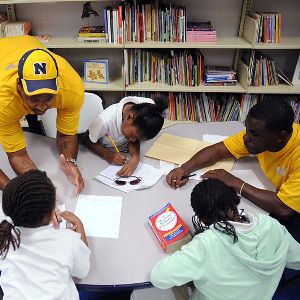 “Afterschool programs, by their very nature, keep kids and youth safe,” said Alexis Steines, Field Outreach Manager at Afterschool Alliance, during a webinar held Thursday titled “Youth Violence Prevention Strategies in Afterschool.”
“Afterschool programs, by their very nature, keep kids and youth safe,” said Alexis Steines, Field Outreach Manager at Afterschool Alliance, during a webinar held Thursday titled “Youth Violence Prevention Strategies in Afterschool.”
She began the event by discussing several Centers for Disease Control and Prevention statistics regarding the impact of violence on the lives of young people. An estimated 4,828 people between the ages of 10 and 24 were the victims of homicide in 2010, she said; additionally, she cited findings that revealed that almost 17 percent of young people have carried weapons on them for a day or more, with 5.4 percent of the nation’s young people admitting to bringing a weapon on school grounds.
During the webinar, Steines called attention to HR 1318, “the Youth Promise Act,” and praised President Barack Obama’s “Now is the Time” plan, which she said could increase funding to “help support changing school climates.”
She also noted several potential federal funding streams for afterschool programming, including the 21st Century Community Learning Centers initiative and the Safe Schools-Healthy Students Initiative.
Afterschool programming, she said, could potentially lower the likelihood of young people engaging in violent activities by reinforcing and supporting positive social behaviors.
Carleen Wray, National Association of Students Against Violence Everywhere (SAVE), said that her organization, which began in 1989, is a student-focused, student-initiated program dedicated to educating and empowering youth.
“SAVE improves school and community environments by teaching students how to manage and resolve conflicts,” she said. “Thereby reducing violence and helping more students get involved in youth safety efforts.”
Citing an Evaluation and Training Institute (ETI) assessment of the program, she said students that participated in SAVE programming generally saw an increase in self-esteem, public speaking skills and knowledge about various violence prevention strategies.
Currently, SAVE has 2,100 chapters in 48 states, with an estimated 23,000 students engaged in activities all across the nation’s elementary schools, high schools, colleges and community organizations.
The programming, which touches upon issues like dating violence, substance abuse and vandalism, teaches students how to appropriately respond to conflict, Wray said. When students feel more engaged with their communities, she said that young people are less likely to engage in violent activities and behaviors.
“Schools and communities will be safer and more secure, free of fear and conducive to learning as a result of students being actively involved in meaningful violence prevention efforts,” Wray said.
Dr. Ben Forman, Teens Run DC Executive Director, is a clinical psychologist who believes that the task of “concerned adults” is to make young people feel better themselves through caring interpersonal relationships and supportive communities.
“Teens Run DC is a youth mentoring program that empowers at-risk youth to envision and work towards the achievement of personal and fitness goals through a distance running program,” he said.
For young people growing up in the “chronic and ongoing trauma” of poverty, dysfunctional homes and substance abuse, he believes his program provides far more for youth than simple exercise.
“Our goals are really to teach life skills,” Forman said.
The program connects young people with mentors and “run leaders” that help participants train and set goals. The one-on-one mentoring relationships, Forman said, help young people find opportunities to succeed by taking incremental steps to manage and achieve their on- and off-track ambitions.
At practice meets, he said that anywhere from 50 to 70 participants usually show up. The determination of the youth — who are asked to wake up at 7 am on the weekend and trek across their neighborhoods to track meetings — demonstrates a reflection of their personal strength and community connection, Forman stated.
At one school the program partnered with, Forman said students routinely scored in the bottom 25th percentile in reading and math, with half of the total student body expected to drop out.
Preoccupied by matters outside of school, such as their home lives and safety concerns, Forman believed that students began believing that trying was useless, and that success was unobtainable.
In the program, Forman said an incremental strategy is employed, which seeks to put students on a “steady pace” towards fulfillment of life goals, rather than emphasizing a “short burst” that would inevitably result in a weak finish.
There are more benefits to the training regiment than just improved track times, Forman said.
“This is a metaphor for their lives,” he concluded.
Photo courtesy of the U.S. Navy





























